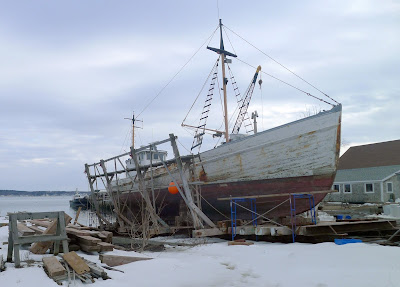| That’s as far as I can go without some better weather. |
The fit-out of the Maine schooner fleet begins in earnest on April 1. That doesn’t mean that their crews haven’t been busy. There’s a lot of dockside work to keep them out of mischief, including mending and refinishing the boats and the shipyard itself. American Eagle and Heritageare immaculate because their crews labor tirelessly to keep the old girls moving. If you’ve ever owned an old house, you understand the necessity.
Occasionally, the weather keeps them busy, too. That happened during March 14’s blizzard. A schooner at Lermond Cove snapped a bowline and threatened boats downwind. The harbormaster, three Coast Guardsmen, and several sailors battled gale-force winds to haul her in. Kudos to Victory Chimes’ Chris Collins for reacting so quickly.
 |
| Jacob Pike from another angle. |
I’ve been watching the Jacob Pikeall winter, waiting for the right combination of warm weather and good light in which to paint her. The best week, of course, was when I was in the Bahamas. Yesterday, on a whim, I asked Shary Cobb Fellows how much longer the old lobster smack was going to be in drydock. “It has to vanish by the first of April,” she told me. The American Eagle needs the spot. “The captains are working on the crane,” she added. That really caught my attention, because their Little Giantcrane is a focal point of the painting I’d envisioned.
I’ve painted in snow many times. I don’t like it. Even when the day is warm, the cold climbs up your legs. “Snow paintings are something artists like and the public doesn’t,” Brad Marshall said, and it’s true. Most people have enough winter without wanting more of it on their walls.
| What sailors do during their down time. |
We still have six inches of slush on the ground. The light was dismal and dark. Nevertheless, the tide was exactly where I wanted it. I decided to block in the painting anyway. I ought to get at least one day next week during which I can finish it.
This is a big work: 18X24. That’s the largest I’ve painted in the field in a long time. I switched easels because that’s far too large for my tiny aluminum pochade box.
 |
| Too much snow for the likes of me. |
Later I walked to the office to say hello. Captains Doug and Linda Lee were there, as was Captain John Foss. They had just finished working on the crane, which has been an all-winter project requiring special-order new parts. Tomorrow they will use it to start putting the railway rollers back in the water.
As I was chatting with Captain Doug, I noticed the view behind him. It was spectacular—the stern of the Jacob Pike, the Little Giant crane front and center, and the bow of the Heritage. Let’s hope I can do it justice. If you’re looking for me, I’ll be down at the boatyard.










